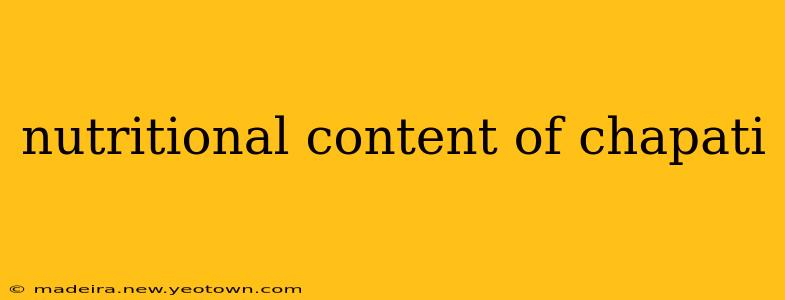Chapati, a staple food across many parts of the world, is more than just a simple flatbread. It's a culinary cornerstone, a comforting presence on countless tables, and surprisingly, a nutritional powerhouse. This isn't just a bland carbohydrate; chapati offers a balanced mix of essential nutrients, making it a valuable component of a healthy diet. Let's delve into the nutritional richness hidden within this humble food.
What are the main nutrients in chapati?
The nutritional profile of chapati depends heavily on the type of flour used (whole wheat vs. refined) and the cooking method. Generally speaking, a chapati made from whole wheat flour offers a significant boost of fiber, complex carbohydrates, and various micronutrients. We'll focus on the benefits of whole wheat chapati, as it's the healthier choice. A single medium-sized whole wheat chapati provides a good source of:
- Complex Carbohydrates: These provide sustained energy release, preventing those mid-afternoon energy crashes.
- Fiber: Crucial for digestive health, fiber promotes regularity and contributes to satiety, helping you feel fuller for longer.
- Protein: Though not a primary protein source, chapati contributes to your daily protein intake.
- Iron: Important for red blood cell production and oxygen transport throughout the body.
- Magnesium: This mineral plays a vital role in numerous bodily functions, including muscle and nerve function, blood sugar control, and blood pressure regulation.
- Manganese: Essential for bone health, wound healing, and metabolism.
- Selenium: An antioxidant that protects cells from damage.
How many calories are in a chapati?
The calorie count of a chapati varies depending on its size and the type of flour used. A medium-sized whole wheat chapati typically contains around 70-100 calories. This makes it a relatively low-calorie food, especially when compared to other carbohydrate sources. Remember, however, that the addition of oil or ghee during preparation will significantly increase the calorie count.
Is chapati good for weight loss?
This is a frequently asked question, and the answer is nuanced. Whole wheat chapati can be a part of a weight-loss diet due to its high fiber content, which promotes satiety and aids digestion. However, moderation is key. Overconsumption of even healthy foods can hinder weight loss efforts. Combining chapati with plenty of vegetables, lean protein, and healthy fats will contribute to a balanced and effective weight loss plan.
What are the benefits of eating chapati?
Beyond the individual nutrients, regular consumption of whole wheat chapati offers several health benefits:
- Improved Digestion: The high fiber content helps regulate bowel movements and prevents constipation.
- Increased Energy Levels: The complex carbohydrates provide sustained energy throughout the day.
- Better Blood Sugar Control: Fiber slows down the absorption of sugar, preventing spikes in blood glucose levels.
- Enhanced Heart Health: Fiber and other nutrients in whole wheat chapati contribute to heart health by lowering cholesterol levels.
Is chapati healthier than roti?
The difference between chapati and roti primarily lies in the cooking method. Chapati is usually cooked directly on a hot griddle, whereas roti might involve the use of more oil or ghee during cooking. While both can be made from whole wheat flour, the added oil in roti tends to increase its calorie and fat content. Therefore, chapati is generally considered a healthier option.
What are the disadvantages of eating chapati?
While chapati is a healthy food, overconsumption can lead to some drawbacks:
- Gluten Sensitivity: Individuals with celiac disease or gluten sensitivity should avoid chapati, as it is made from wheat flour.
- High Glycemic Index (refined flour): Chapati made from refined wheat flour has a higher glycemic index than its whole wheat counterpart, leading to potential blood sugar spikes.
In conclusion, chapati, especially when made from whole wheat flour, is a nutritional powerhouse offering a wide range of health benefits. Incorporating it into a balanced diet can contribute to improved digestion, sustained energy, and overall well-being. However, mindful consumption and awareness of potential drawbacks are crucial for maximizing its nutritional value.

